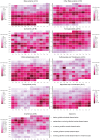The impact of policy guidelines on hospital antibiotic use over a decade: a segmented time series analysis
- PMID: 24647339
- PMCID: PMC3960230
- DOI: 10.1371/journal.pone.0092206
The impact of policy guidelines on hospital antibiotic use over a decade: a segmented time series analysis
Abstract
Introduction: Antibiotic pressure contributes to rising antibiotic resistance. Policy guidelines encourage rational prescribing behavior, but effectiveness in containing antibiotic use needs further assessment. This study therefore assessed the patterns of antibiotic use over a decade and analyzed the impact of different modes of guideline development and dissemination on inpatient antibiotic use.
Methods: Antibiotic use was calculated monthly as defined daily doses (DDD) per 100 bed days for nine antibiotic groups and overall. This time series compared trends in antibiotic use in five adjacent time periods identified as 'Segments,' divided based on differing modes of guideline development and implementation: Segment 1--Baseline prior to antibiotic guidelines development; Segment 2--During preparation of guidelines and booklet dissemination; Segment 3--Dormant period with no guidelines dissemination; Segment 4--Booklet dissemination of revised guidelines; Segment 5--Booklet dissemination of revised guidelines with intranet access. Regression analysis adapted for segmented time series and adjusted for seasonality assessed changes in antibiotic use trend.
Results: Overall antibiotic use increased at a monthly rate of 0.95 (SE = 0.18), 0.21 (SE = 0.08) and 0.31 (SE = 0.06) for Segments 1, 2 and 3, stabilized in Segment 4 (0.05; SE = 0.10) and declined in Segment 5 (-0.37; SE = 0.11). Segments 1, 2 and 4 exhibited seasonal fluctuations. Pairwise segmented regression adjusted for seasonality revealed a significant drop in monthly antibiotic use of 0.401 (SE = 0.089; p<0.001) for Segment 5 compared to Segment 4. Most antibiotic groups showed similar trends to overall use.
Conclusion: Use of overall and specific antibiotic groups showed varied patterns and seasonal fluctuations. Containment of rising overall antibiotic use was possible during periods of active guideline dissemination. Wider access through intranet facilitated significant decline in use. Stakeholders and policy makers are urged to develop guidelines, ensure active dissemination and enable accessibility through computer networks to contain antibiotic use and decrease antibiotic pressure.
Conflict of interest statement
Figures
References
-
- WHO. The top 10 causes of death (n.d.). WHO. Available: http://www.who.int/mediacentre/factsheets/fs310/en/index.html. Accessed 2013 July 23.
-
- Gagliotti C, Balode A, Baquero F, Degener J, Grundmann H, et al... (2011) Escherichia coli and Staphylococcus aureus: bad news and good news from the European Antimicrobial Resistance Surveillance Network (EARS-Net, formerly EARSS), 2002 to 2009. Euro Surveill Bull Eur Sur Mal Transm Eur Commun Dis Bull 16. - PubMed
Publication types
MeSH terms
Substances
LinkOut - more resources
Full Text Sources
Other Literature Sources
Medical
Research Materials




